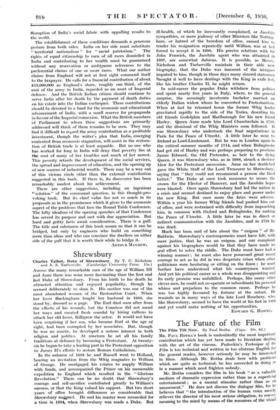The Future of the Film
The Film Till Now. By Paul Rothe. (Cape. 10s. fad.) MR. PAUL ROTIIA'S book is undoubtedly the most important contribution which has yet been made to literature dealing with the art of the cinema. Pudovkin's Technique of the Film is too technical and written in too abstruse English for the general reader, however seriously he may be interested in films. Although Mr. Rotha deals here with problems which are quite as technical, he has succeeded in doing so in a manner which need frighten nobody. Mr. Rotha considers the film in his book " as a valuable medium of dramatic expression rather than as a superficial entertainment ; as a mental stimulus rather than as an amusement." He does not discuss the dialogue film, for he believes that " the introduction of the human voice merely relieves the director of his most serious obligation, to convey nreassing to the mind by means of the resources of the visual
cinema." Although as a mechanical invention the dialogue film is marvellous, he considered the introduction of dialogue ruins the very essence of the film, as a medium of expression :—
" A film is primarily a dynamic pattern or rhythm (achieved by the editing and cutting) imposed on nature (the material taken, preferably the reality). It is governed pictorically by the use of light and movement in the creation of visual images, and mentally by psychology in the creation of mental images. Music and syn- chronized sound, used in counterpoint, and contrapuntally, heighten the emotions of the spectator aurally and subconsciously. This dynamic mental pictorialism is, I claim, the most powerful form of expression available to-day to a creative artist."
Or in greater detail :—
" A film demands that a theme—either personal, impersonal, or inanimate—sbail be presented to the mind through the eye by the flowing relation and inter-relation of a succession of visual images projected on a screen. It further requires the theme to he emphasized by the full range of cinematic resources by the use of the intimate to reinforce the general at a similar moment or in development ; by the instantaneous pictorial vision of more than one idea at the same time ; by symbolism and suggestion ; by the association of ideas and shapes ; by the varying high and low tensions caused by rhythmic cutting ; by variation in the intensities of light ; by the contrast and similarity of sounds ; by all the intrinsic properties peculiar to the medium of the film. The film possesses the power of expanding and contracting the centre of interest, and of comparison by rapid change of the relation- ship of the trivial to the essential. By these means may the audience bo compelled to accept the dramatic meaning of the theme and to realize its continually developing content."
A film is able to create its own time. " Dialogue, by very reason of its realism, represents real time and not filmic time of the visual image." Dialogue also necessitates the telling of a story by words rather than by visual images. It is in direct contradiction to filmic art. Mr. Rotha's final statement on the place which the dialogue film can legiti- mately hold is logical :— " There can only bo one legitimate use for the dialogue film and that is the topical-news and gazette reel. Here the appeal to the mind is quite different, for there is no aim at dramatic effect in news.spoeches. They are simply a record in which the interest lies more in the speech than in the visual image. They are not constructed films seeking to achieve the dramatic effect of a story. They are an elementary form of the cinema without joy,' and, considered as such, are only of casual and historic interest."
The first half of this book is devoted to a critical account of the contribution which America, the Soviet Union, Germany, France, Great Britain, and other countries have made to the development of the film. Mr. Rotha's critical faculty is acute. He also describes very ably the process of making a film, from the selection of a theme to its editing and cutting. It would surprise most people to learn how complicated it is and what diverse talents are necessary for this work. Mr. Botha looks forward to the day when the purely entertain- ment dialogue film will cease to entertain, and when the public will demand to be shown films which are examples of the most resourceful expression in this art.



























































 Previous page
Previous page